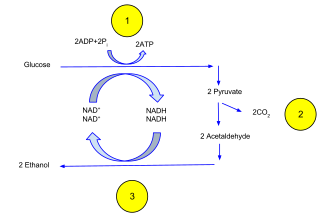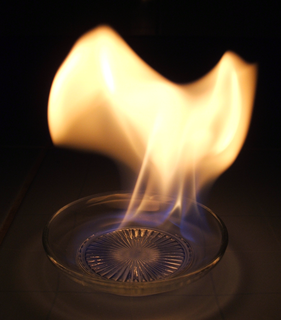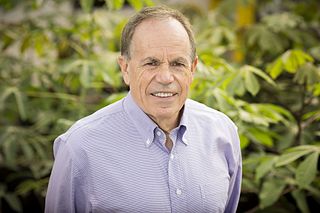
Lawrence Berkeley National Laboratory (LBNL), commonly referred to as Berkeley Lab, is a United States national laboratory that conducts scientific research on behalf of the Department of Energy. Located in the hills of Berkeley, California, the lab overlooks the campus of the University of California, Berkeley.

Biofuel is a fuel that is produced through contemporary processes from biomass, rather than by the very slow geological processes involved in the formation of fossil fuels, such as oil. Since biomass technically can be used as a fuel directly, some people use the terms biomass and biofuel interchangeably. More often than not, however, the word biomass simply denotes the biological raw material the fuel is made of, or some form of thermally/chemically altered solid end product, like torrefied pellets or briquettes.

Ethanol fuel is ethyl alcohol, the same type of alcohol found in alcoholic beverages, used as fuel. It is most often used as a motor fuel, mainly as a biofuel additive for gasoline. The first production car running entirely on ethanol was the Fiat 147, introduced in 1978 in Brazil by Fiat. Ethanol is commonly made from biomass such as corn or sugarcane. World ethanol production for transport fuel tripled between 2000 and 2007 from 17×109 liters (4.5×109 U.S. gal; 3.7×109 imp gal) to more than 52×109 liters (1.4×1010 U.S. gal; 1.1×1010 imp gal). From 2007 to 2008, the share of ethanol in global gasoline type fuel use increased from 3.7% to 5.4%. In 2011 worldwide ethanol fuel production reached 8.46×1010 liters (2.23×1010 U.S. gal; 1.86×1010 imp gal) with the United States of America and Brazil being the top producers, accounting for 62.2% and 25% of global production, respectively. US ethanol production reached 57.54×109 liters (1.520×1010 U.S. gal; 1.266×1010 imp gal) in 2017–04.

Ethanol fermentation, also called alcoholic fermentation, is a biological process which converts sugars such as glucose, fructose, and sucrose into cellular energy, producing ethanol and carbon dioxide as by-products. Because yeasts perform this conversion in the absence of oxygen, alcoholic fermentation is considered an anaerobic process. It also takes place in some species of fish where it provides energy when oxygen is scarce.
Cellulosic ethanol is ethanol produced from cellulose rather than from the plant's seeds or fruit. It can be produced from grasses, wood, algae, or other plants. It is generally discussed for use as a biofuel. The carbon dioxide that plants absorb as they grow offsets some of the carbon dioxide emitted when ethanol made from them is burned, so cellulosic ethanol fuel has the potential to have a lower carbon footprint than fossil fuels.

Various alcohols are used as fuel for internal combustion engines. The first four aliphatic alcohols are of interest as fuels because they can be synthesized chemically or biologically, and they have characteristics which allow them to be used in internal combustion engines. The general chemical formula for alcohol fuel is CnH2n+1OH.

The U.S. Department of Energy (DOE) Joint Genome Institute (JGI), first located in Walnut Creek then Berkeley, California, was created in 1997 to unite the expertise and resources in genome mapping, DNA sequencing, technology development, and information sciences pioneered at the DOE genome centers at Lawrence Berkeley National Laboratory, Lawrence Livermore National Laboratory (LLNL) and Los Alamos National Laboratory (LANL). As a DOE Office of Science User Facility of Berkeley Lab, the JGI staff is composed of employees from Berkeley Lab, LLNL and the HudsonAlpha Institute for Biotechnology. The JGI also collaborates with other DOE-supported programs and facilities, such as the Environmental Molecular Sciences Laboratory at Pacific Northwest National Laboratory (PNNL), the National Energy Research Scientific Computing Center, or NERSC, and the DOE Bioenergy Research Centers.

Jay D. Keasling is a professor of chemical engineering and bioengineering at the University of California, Berkeley. He is also associate laboratory director for biosciences at the Lawrence Berkeley National Laboratory and chief executive officer of the Joint BioEnergy Institute. He is considered one of the foremost authorities in synthetic biology, especially in the field of metabolic engineering.

Energy crops are low-cost and low-maintenance crops grown solely for energy production by combustion. The crops are processed into solid, liquid or gaseous fuels, such as pellets, bioethanol or biogas. The fuels are burned to generate electrical power or heat.
The United States produces mainly biodiesel and ethanol fuel, which uses corn as the main feedstock. The US is the world's largest producer of ethanol, having produced nearly 16 billion gallons in 2017 alone. The United States, together with Brazil accounted for 85 percent of all ethanol production, with total world production of 27.05 billion gallons. Biodiesel is commercially available in most oilseed-producing states. As of 2005, it was somewhat more expensive than fossil diesel, though it is still commonly produced in relatively small quantities.

Butanol may be used as a fuel in an internal combustion engine. It is more similar to gasoline than it is to ethanol. A C4-hydrocarbon, butanol is a drop-in fuel and thus works in vehicles designed for use with gasoline without modification. Both n-butanol and isobutanol have been studied as possible fuels. Both can be produced from biomass as well as from fossil fuels. The chemical properties depend on the isomer, not on the production method.

Biofuel is fuel that is produced from organic matter (biomass), including plant materials and animal waste. It is considered a renewable source of energy that can assist in reducing carbon emissions. The two main types of biofuel currently being produced in Australia are biodiesel and bioethanol, used as replacements for diesel and petrol (gasoline) respectively. As of 2017 Australia is a relatively small producer of biofuels, accounting for 0.2% of world bioethanol production and 0.1% of world biodiesel production.

Acetone–butanol–ethanol (ABE) fermentation is a process that uses bacterial fermentation to produce acetone, n-Butanol, and ethanol from carbohydrates such as starch and glucose. It was developed by chemist Chaim Weizmann and was the primary process used to produce acetone, which was needed to make cordite, a substance essential for the British war industry during World War I.
Second-generation biofuels, also known as advanced biofuels, are fuels that can be manufactured from various types of non-food biomass. Biomass in this context means plant materials and animal waste used especially as a source of fuel.
The Joint BioEnergy Institute (JBEI) is a research institute funded by the United States Department of Energy. JBEI is led by the Lawrence Berkeley National Laboratory, and includes participation from the Sandia National Laboratory, Lawrence Livermore National Laboratory, as well as UC Berkeley, UC Davis, Iowa State University, and the Carnegie Institute. JBEI is located in Emeryville, California.

Gevo, Inc. is a renewable chemicals and advanced biofuels company headquartered in unincorporated Douglas County, Colorado in the Denver-Aurora metropolitan area. Gevo is focused on sustainability, using the business model based on the Circular Economy to incorporate renewable energy from a range of sources, de-fossilization of its processes, regenerative agriculture, sequestration of carbon in the soil, systemwide efficiency, and conservation of resources to enhance all of its products. The company develops bio-based alternatives to petroleum-based products using a combination of biotechnology and classical chemistry. Gevo uses the GREET model from Argonne National Laboratory as a basis for its measure of sustainability with the goal of producing high-protein animal feed, corn-oil products, energy-dense liquid hydrocarbons, from every kernel of corn. Gevo is focused on converting sustainably grown raw materials, specifically no. 2 dent corn, into high-value protein and isobutanol, the primary building block for its renewable hydrocarbons, including sustainable aviation fuel, renewable gasoline, and renewable diesel. Gevo believes these fuels can be directly integrated on a “drop in” basis into existing fuel and chemical products. Gevo's investors include Burrill & Company, Khosla Ventures, Lanxess, Osage University Partners, Total, and Virgin Green Fund, among others.
Inbicon is a Danish company that produces cellulosic ethanol.

The Great Lakes Bioenergy Research Center (GLBRC) is one of four bioenergy research centers established in 2007 by the U.S. Department of Energy. It is led by the University of Wisconsin-Madison with Michigan State University as a primary partner. The goal of GLBRC is to create biofuels and bioproducts that are economically viable and environmentally sustainable. GLBRC provides a collaborative environment in which researchers with diverse backgrounds are drawn together by their pursuit of scientific questions related to developing sustainable biofuels and bioproducts. GLBRC research focuses on engineering bioenergy crops to enhance their environmental and economic value, generating multiple products from plant biomass, and optimizing the field-to-product pipeline. Its research is integrated across many disciplines and areas of focus, coordinating efforts between academic, federal, and private sector bodies as part of the field-to-product pipeline.

Stephen Patrick Long is a British-born American environmental plant physiologist and member of the National Academy of Sciences studying how to improve photosynthesis to increase the yield of food and biofuel crops. He is the Stanley O. Ikenberry Chair Professor of Plant Biology and Crop Sciences at the University of Illinois and Distinguished Professor in Crop Sciences at Lancaster University. His work, published in Science, proved that photosynthesis can be manipulated to increase plant productivity—an idea once considered the holy grail of plant biology. Long has added to our understanding of the long-term impacts of climate change, such as rising levels of carbon dioxide and ozone on plants. He has briefed former President George W. Bush and the Vatican, as well as Bill Gates and Anne, Princess Royal, on food security and bioenergy.
Christopher Roland Somerville is a Canadian-American biologist known as a pioneer of Arabidopsis thaliana research. Somerville is currently Professor Emeritus at the University of California, Berkeley and a Program Officer at the Open Philanthropy Project.












